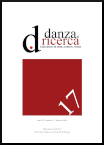«Non muovere né l’anima senza il corpo, né il corpo senza anima». Le pratiche del ritmo nel “Timeo” e nelle “Leggi” di Platone
DOI:
https://doi.org/10.6092/issn.2036-1599/20923Abstract
In Plato's thought, rhythmic activity takes on fundamental importance: it is understood by the philosopher as the ability of human beings to tune in to the rhythms of the cosmos and to participate in the cosmogonic force of the demiurge, the orderer and “choreographer” of the universe. In the Timaeus, precisely because of its kinetic and rhythmic dimension, the practice of imitating the rhythms of the stars is conceived by Plato as the main cure for the “imbalances” that the soul encounters when incarnated in a mortal body. In the Laws, on the other hand, Plato bases the theory of education through choral dance on the aforementioned capacity for rhythm and movement, activities that are associated to pleasure and joy.
Downloads
Published
How to Cite
Issue
Section
License
Copyright (c) 2024 Simona Donato

This work is licensed under a Creative Commons Attribution-NonCommercial 3.0 Unported License.




